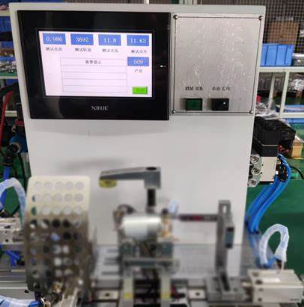What are the common mechanical failures and solutions for brushless motor motor automatic load tester?
Brushless motor motor automatic load tester common mechanical failures and solutions are as follows:
First, the transmission system failure
1、Belt transmission failure
Failure performance: the belt slips, resulting in unstable motor speed or can not reach the set speed; belt wear is serious, cracks or breaks.
Failure causes: belt tension is insufficient; natural aging of the belt for long-term use; pulley wear or installation is not parallel.
Solution: Adjust the belt tensioning device, so that the belt to achieve the appropriate tension; timely replacement of badly worn or broken belt; check the wear of the pulley, if worn, then replace the pulley, while ensuring that the pulley is installed parallel.
2、Gear transmission failure
Failure performance: abnormal noise when the gear mesh; gear wear is serious, broken teeth phenomenon; transmission process of jamming or impact.
Failure causes: insufficient gear lubrication; gear installation accuracy is not enough, the meshing gap is too large or too small; gear material problems or long-term overload operation.
Solution: regularly add or replace the appropriate gear lubricant; re-adjust the installation position of the gear to ensure that the meshing gap is appropriate; for serious wear or broken gears, timely replacement; to avoid long-term overload operation of the test machine, a reasonable choice of gear materials and specifications.
Second, bearing failure
1、Bearing heat
Failure performance: bearing temperature is too high during operation, even smoke phenomenon.
Failure causes: insufficient or deteriorated bearing grease; bearing installation is too tight or too loose; bearing quality problems or long-term use of fatigue wear.
Solution: Supplement or replace the appropriate grease; check the installation of bearings, adjust the installation tightness; if the quality of the bearings or wear and tear is serious, replace the bearings in a timely manner.
2、Bearing noise
Failure performance: bearings in the operation of the abnormal sound, such as creaking sound, buzzing sound.
Failure causes: foreign matter in the bearing; bearing raceway or rolling body wear, scratches; bearing clearance is too large or too small.
Solution: disassemble the bearing, clean it and check whether there are foreign materials, if any, then clear off; check the surface condition of the bearing raceway and rolling body, if there is wear and tear or scratches, then replace the bearing; adjust the clearance of the bearing, so that it reaches the appropriate value.

Third, the test fixture failure
1、Loose fixture
Failure performance: During the test, the fixture can not firmly fix the brushless motor, resulting in the motor shaking or shifting, affecting the accuracy of the test results.
Cause: The fastening bolts of the fixture are loose; the clamping mechanism of the fixture is worn or damaged.
Solution: Regularly check and tighten the fastening bolts of the fixture; check the wear and tear of the clamping mechanism, replace the worn parts, repair or replace the damaged clamping mechanism.
2、Inaccurate positioning of the fixture
Failure performance: motor installation position deviation, resulting in testing the motor's axis and the tester's transmission axis does not coincide, resulting in additional stress and vibration.
Failure causes: fixture positioning elements wear; fixture deformation after long-term use.
Solution: Replace the worn positioning elements; repair or replace the deformed fixture to ensure the positioning accuracy of the fixture.
Fourth, the mechanical connection components failure
1, coupling failure
Failure performance: coupling in the transmission process loosening, displacement; coupling elastic element damage, resulting in reduced transmission efficiency or vibration.
Failure causes: coupling connection bolts loose; long-term use of the elastic element caused by aging, wear; installation of the coupling concentricity deviation is too large.
Solution: tighten the connecting bolts; timely replacement of damaged elastic components; re-adjust the concentricity of the coupling installation to ensure that it is within the allowable range.
2、Key connection failure
Failure performance: the key is loose in the keyway, resulting in transmission slippage; key wear is serious, affecting power transmission.
Failure causes: key size is not suitable or installation is not installed in place; long-term use of the key and keyway wear.
Solution: Choose the right size of key and install it correctly; for the key and keyway with serious wear, repair or expand the keyway and replace the key with a new one.
※ If the above ways and means still can not solve the fault of the equipment, please contact the technical specialist of Xinhui Mechanical & Electrical Equipment Ltd. through the page chat tool to seek help.







